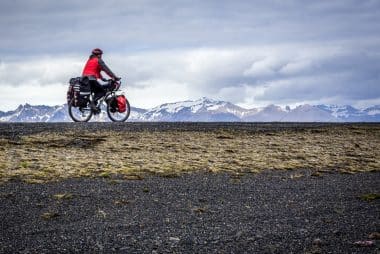A bike tour with an overnight stay in nature is something terrific. Break out of everyday life for a few days, decide for yourself where you sleep, how long you are on the road and which route you follow. Feel the wind and freedom literally on your face – these are just some of the reasons why bikepacking is becoming increasingly popular in this country.
Bikepacking combines the basic elements of cycling with minimalist camping and the thrill of cycling off paved roads and cycle paths.
Whether it’s a tour abroad lasting several weeks, a crossing of the Alps with a tent or a spontaneous multi-day excursion with an overnight stay in a youth hostel. There is no rigid definition of bikepacking. Everyone has their own idea of freedom and adventure. Bikepacking is therefore first and foremost what you make of it yourself.
Bikepacking versus bike travel – What are the differences?
Classic cycle tours usually take place on paved roads and cycle paths. Bikepacking, on the other hand, involves off-road riding on dirt or gravel paths or on narrow trails and forest paths.
In contrast to conventional bike tours with the touring or trekking bike, bikepacking is largely independent of luggage racks and large, heavy bags.
Instead of the traditional touring bag set-up (rear rack with two pockets plus two panniers at the front and a handlebar bag), flexible and lightweight bikepacking bags are used.
Which bike is suitable for bikepacking?
Weight optimization, agility and practicality are a strong focus when it comes to bikepacking. A “bikepacking bike” must therefore be able to master the different track conditions while remaining agile and comfortable.
Mountain bikes, cyclocrossers or gravel bikes are predestined for use on a bikepacking tour. To start bikepacking, however, you don’t have to buy a new bike right away.
Many cycling enthusiasts already have a bike in their basement or garage that is easily suitable for bikepacking. If not, it may be possible to borrow a bike from friends or acquaintances for the start of the bikepacking.
Less is more – The Bikepacking Bags
When talking about a bikepacking setup, this set usually includes a:
- Saddlebag;
- a handlebar bag;
- and a frame bag.
Additional transport volume is created by smaller accessory bags.
These include:
- Top tube pockets;
- stem pockets;
- and fork pockets;
It is not uncommon for bikepackers to use backpacks or hip bags to create additional storage space. Waterproof dry bags are used to protect clothing or equipment from moisture.
The special bikepacking bags not only score with their low weight, they also offer the advantage that no luggage racks or mounting points are necessary to attach them to the bike.
Bikepacking bags are attached with the help of straps / Velcro fasteners and can thus be attached to almost any frame geometry.
Reduced to the bare essentials – the bikepacking equipment

Lower weight increases agility, performance and the fun factor. That’s why the motto for bikepacking is “less is more”. This means that a loaded bike can also be steered quickly and safely through challenging terrain.
Bikepacking bags offer less storage space than conventional panniers anyway. The equipment should therefore be thoroughly considered in advance of a tour.
Which pieces of equipment must be taken with you and what can you safely do without?
Tip: A packing list helps to keep track of everything.
The equipment you need for a bikepacking tour is very individual. The equipment can change depending on the route, weather conditions and experience.
If you want to spend the night and cook on the way, some basic equipment is necessary in addition to the bike and the matching bikepacking bags:
Sleep system
The sleeping system consists of a sleeping bag, sleeping mat and weather protection – usually a tent. Minimalists swear by lightweight tarps (weather protection tarps) or bivouac bags (weather protection cover for a sleeping bag) to reduce the weight of the sleeping system as much as possible.
Outdoor kitchen
If you want to take care of yourself on the way, a camping stove incl. Pot and light outdoor cutlery in the panniers. Needed food is either carried along or bought in supermarkets on the way. Sufficient drinking water should also be provided at all times.
Clothing
In addition to the worn cycling clothes, a change of clothes and also clothes for the camp in the evening should be packed. What and how much is needed depends largely on the season and weather conditions.
Tool
To ensure that the first bikepacking tour does not fail because of a flat tire, it should be possible to carry out minor repairs on the way. A so-called multitool, repair kit and an air pump are therefore part of the basic mobile workshop equipment.
Toiletries
Personal medication, dental and personal care as well as a microfiber towel ensure a minimum of hygiene during a bikepacking tour. In addition, a first aid kit should not be missing from any packing list.
Electronics
It is highly recommended to carry an additional lamp (flashlight or headlamp) and to ensure the energy supply with a power bank (external battery). Especially if navigation takes place via smartphone. Don’t forget the right plugs, cables and chargers.
Get on, drive off and try it out
Everyone has started at some point! If you would like to try bikepacking, you should not be unsettled by new terms or extensive packing lists at first.
In the beginning, a few pieces of equipment are often enough to put the first bikepacking adventure into practice.
According to the “trial and error principle”, you find out pretty well over time what is important to you and what you don’t need on the road
You will be rewarded with great outdoor moments and unforgettable memories.
Happy Bikepacking!


